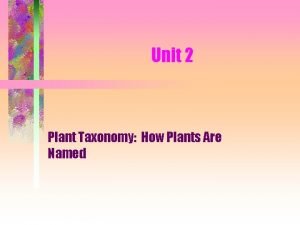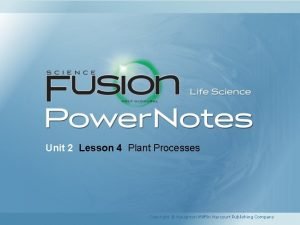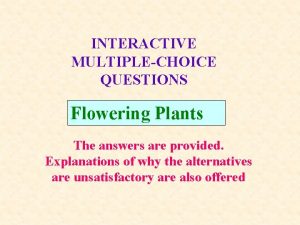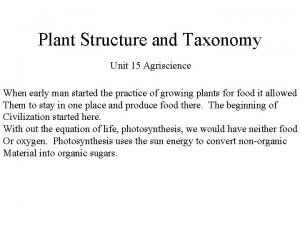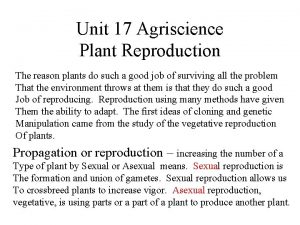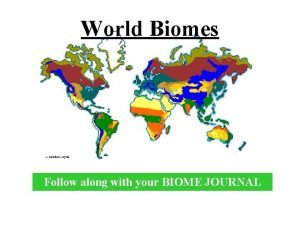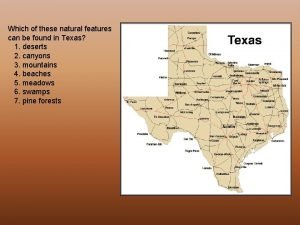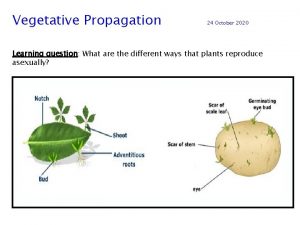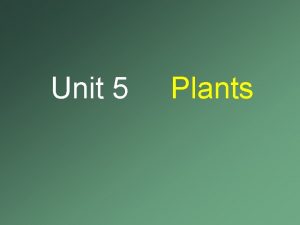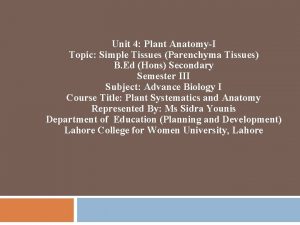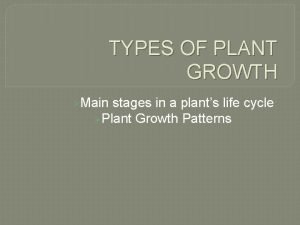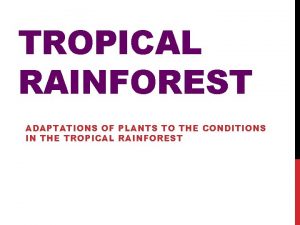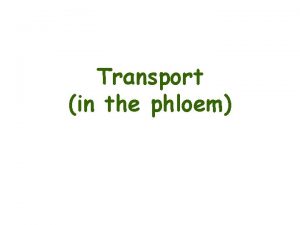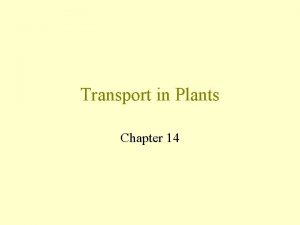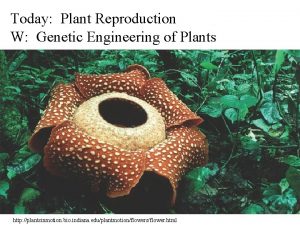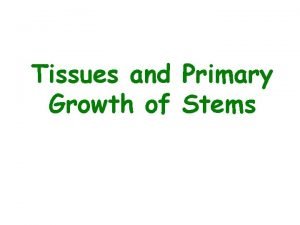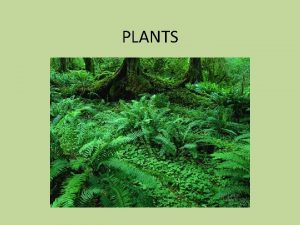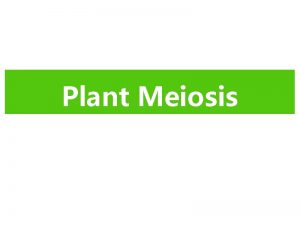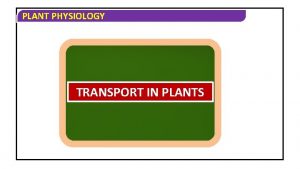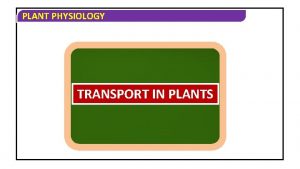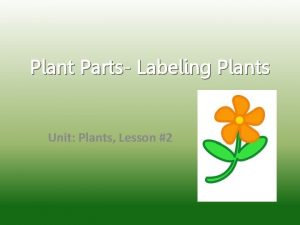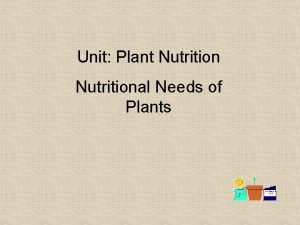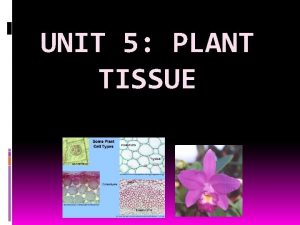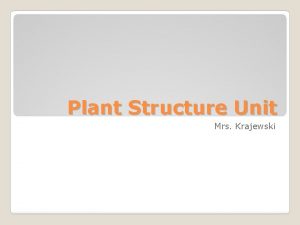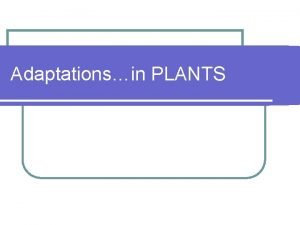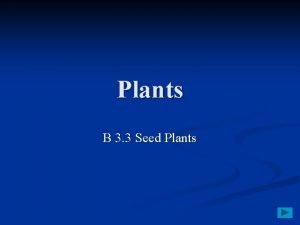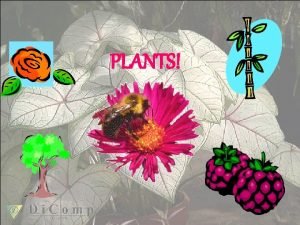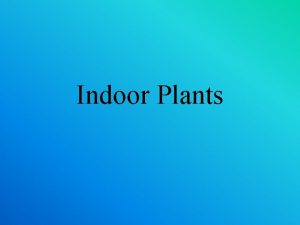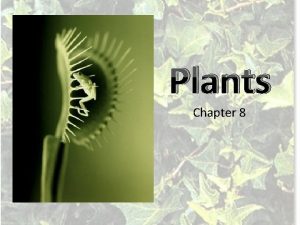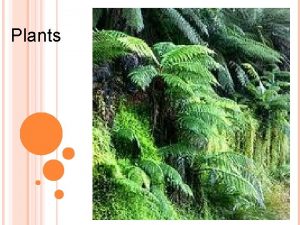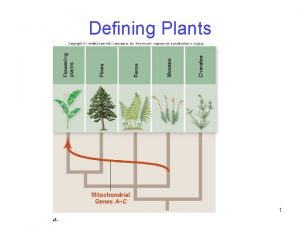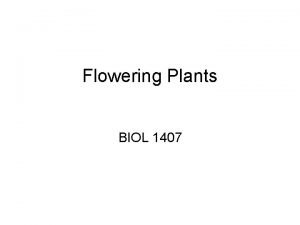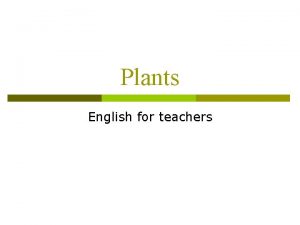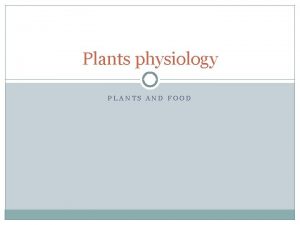Plants Unit 6 Questions Unit 6 Plant Questions





























- Slides: 29

Plants: Unit 6 Questions

Unit 6: Plant Questions 1. Plants probably evolved from green algae (protists) 2. The greatest challenge to land plants = developing adaptations to prevent water loss 3 Primary adaptation that helped plants survive on land = develop adaptations to keep gametes from drying out 4. The life (reproductive) cycles of all plants include spore production 5. Alternation of generation = Includes a haploid gametophyte generation alternating with a diploid sporophyte generation; ** ALL PLANTS**

Alternation of Generations and Multicellular Dependent Embryos • The multicellular gametophyte is haploid and produces haploid gametes by mitosis. • Fusion of the gametes gives rise to the diploid sporophyte, which produces haploid spores by meiosis. • The diploid embryo is retained within the tissue of the female gametophyte. Nutrients are transferred from parent to embryo through placental transfer cells. • Land plants are called embryophytes because of the dependency of the embryo on the parent.

Land Plants Life Cycle Gametophyte (n) Mitosis n n Spore MEIOSIS Gamete from another plant Mitosis n n Gamete FERTILIZATION 2 n Zygote Mitosis Sporophyte (2 n) Alternation of generations = Derived traits of land plants

Green Algae and Cuticle Pictures

• 6. Plants often have large numbers of the same organs (roots, leaves); animals usu. have 1 or 2 of the same organ • 7. Root functions: get nutrients & water from soil; anchors plant in soil; stores food • 8. Stem functions: structural support for upright growth; display leaves; stores food • 9. Roots & stems are organs that store food • 10. The waxy, waterproof material covering stems, leaves, & fruit = cuticle • 11. Plant organs that make food = leaves

Functions of Root, Stems, Leaves

12. Stems allow leaves to be exposed to more sunlight =more food production 13. The openings found in the cuticles of leaves allowing gas exchange = stomata 14. Guard cells open and close the stomata. 15. Vascular plants have specialized tissue for transporting food and water throughout plants Non-vascular plants DO NOT have specialized tissue for transporting food and water throughout plants; small in size and must live near water

• 16. Vascular tissue moves materials faster & over larger spaces • 17. Nonvascular plants belong to division Bryophyta(ex. Moss & liverwort) • 18. Nonvascular plants are smaller because they depend on diffusion and osmosis • 19. The most primitive vascular plants reproduce by spores

Bryophyta-Non-Vascular Plants Mosses, Liverworts, Hornworts

• 20. Tissue that carries food in a vascular plant = phloem • 21. Specialized plant tissue carrying water & minerals = xylem • l

PARTS OF A LEAF

• 22. The 2 most highly evolved (complex) divisions of vascular plants are: – A. Angiosperms (flowering plants) – B. Gymnosperms – ( Non-flowering plants; Naked Seeds – AKA Conifers (evergreens)

24 Angiosperm 23. Gymnosperms Flowering plants • Seeds are inside fruit Usually • “Naked seeds” = cone • Usually evergreens • Pine trees, Fir, Cycads, Gingko deciduous Apple trees (most) Conebearing plants

25. Both cones and flowers are reproductive structures 26. Angiosperms are the most successful land plants


Seed Cones (Gymnosperm) vs Seed Fruit (Angiosperm

27. 2 classes of angiosperm Monocots Dicots • Has 1 embryonic seed leaf • • Leaves with parallel • veins • Flowering parts in multiples of 3 • Embryonic food • source = endosperm • Has 2 embryonic seed leaves Branching or netted leaf veins Flowering parts in multiples of 4 or 5 Embryonic food source = cotyledon

MONOCOT VS DICOT

28. Primary -Height growth; rapid cell division in apical meristem Secondary – Growth in width or diameter; rapid cell division in vascular cambian Annual rings – Tells the age of trees 29 things needed for seed germination – Water, oxygen, suitable temperature

30. 4 ways plants disperse seeds – – Animals (cling to fur, clothing) Animals (through digestive tracts) Wind, water Explosion

31 1. Annuals – Plants that live 1 growing season ex. Corn, lettuce, marigolds, petunias, gerber daisies 2. Biennials – Plants that live for 2 growing seasons ex. Beets, carrots, cabbage, celery 3. Perennials – Plants that live multiple growing seasons ex. Mint, maple, pines, roses

32. PARTS OF A FLOWER

FLOWER PART FUNCTIONS

33 & 34 DICOT VS MONOCOT SEEDS

Highlights of Plant Evolution 1 Origin of land plants (about 475 mya) 2 Origin of vascular plants (about 420 mya) 3 Origin of extant seed plants (about 305 mya) Hornworts 1 Mosses Pterophytes (ferns, horsetails, whisk ferns) 3 Angiosperms 450 400 350 300 Millions of years ago (mya) 50 0 Seed plants Gymnosperms Vascular plants 2 Seedless vascular plants Lycophytes (club mosses, spike mosses, quillworts) 500 Land plants ANCESTRAL GREEN ALGA Nonvascular plants (bryophytes) Liverworts

EVOLUTION OF PLANTS


SUMMARY
 Unit 2 plant taxonomy how plants are named
Unit 2 plant taxonomy how plants are named Vascular plants vs nonvascular plants
Vascular plants vs nonvascular plants Nonvascular plant diagram
Nonvascular plant diagram Classification of non flowering plants
Classification of non flowering plants C3 plants vs c4 plants
C3 plants vs c4 plants Plant introduction in plant breeding
Plant introduction in plant breeding Taichum
Taichum Plant introduction in plant breeding
Plant introduction in plant breeding Tronsmo plant pathology and plant diseases download
Tronsmo plant pathology and plant diseases download Tronsmo plant pathology and plant diseases download
Tronsmo plant pathology and plant diseases download Tronsmo plant pathology and plant diseases download
Tronsmo plant pathology and plant diseases download Unit 2 lesson 12 flowering plants
Unit 2 lesson 12 flowering plants Multiple choice questions on flowering plants
Multiple choice questions on flowering plants Unit 10, unit 10 review tests, unit 10 general test
Unit 10, unit 10 review tests, unit 10 general test Unit 15 plant structures and taxonomy
Unit 15 plant structures and taxonomy Unit 17 plant reproduction
Unit 17 plant reproduction Classification of plants
Classification of plants Bougainvillea adaptations
Bougainvillea adaptations Average annual rainfall in south texas brush country
Average annual rainfall in south texas brush country Plants reproduce asexually
Plants reproduce asexually Absorption and movement of water in root cells
Absorption and movement of water in root cells Vegetative propagation examples
Vegetative propagation examples Characteristics of plants
Characteristics of plants Parenchyma
Parenchyma Monocarpic plants
Monocarpic plants Tropical rainforest adaptations
Tropical rainforest adaptations Bulk flow in phloem
Bulk flow in phloem Transpiration in plants
Transpiration in plants How do plants reproduce
How do plants reproduce Interfascicular cambium is primary or secondary
Interfascicular cambium is primary or secondary
